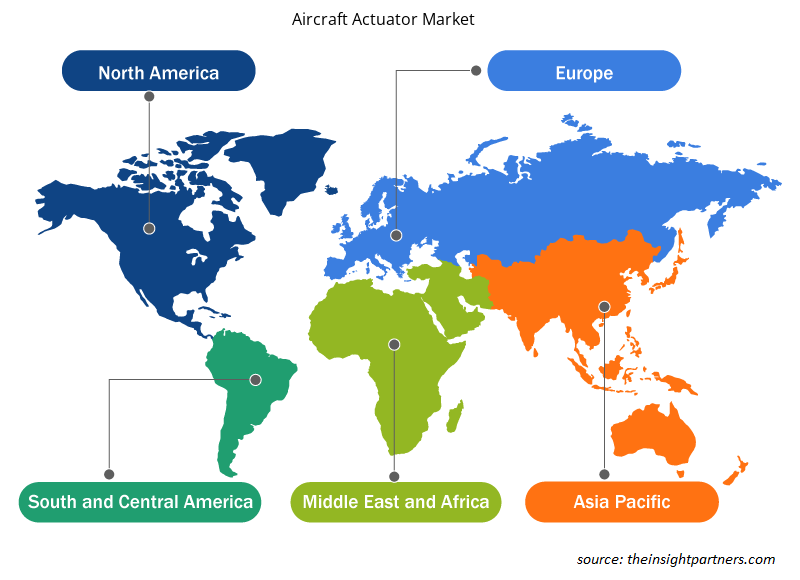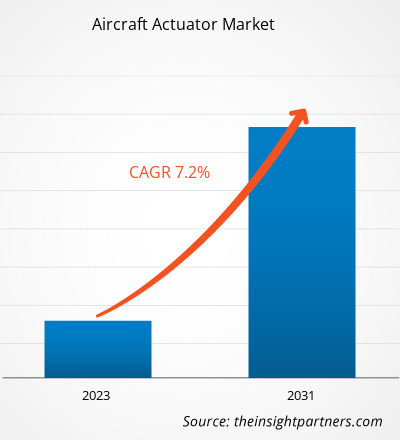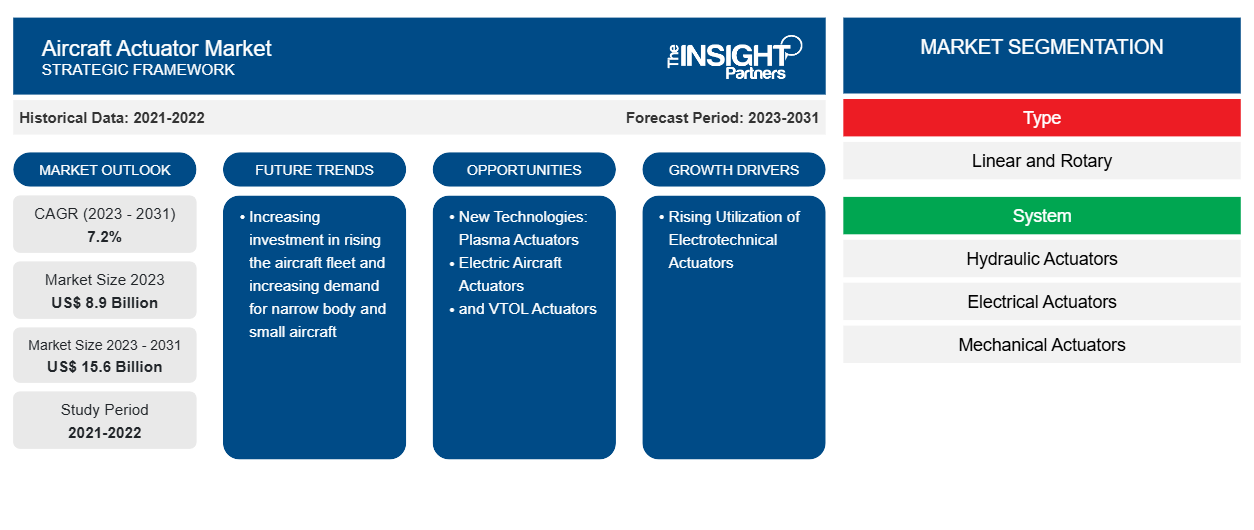Si prevede che la dimensione del mercato degli attuatori per aeromobili raggiungerà i 15,6 miliardi di dollari entro il 2031, rispetto agli 8,9 miliardi di dollari del 2023. Si prevede che il mercato registrerà un CAGR del 7,2% nel 2023-2031. L'aumento degli investimenti per aumentare la flotta di aeromobili e la crescente domanda di aeromobili a fusoliera stretta e di piccole dimensioni sono tra i fattori chiave che guidano il mercato degli attuatori per aeromobili.
Analisi del mercato degli attuatori per aeromobili
La crescita del mercato degli attuatori per aeromobili è guidata principalmente da investimenti significativi in tecnologie avanzate nel settore dell'aviazione. Negli ultimi vent'anni, il settore dell'aviazione (commerciale e militare) è cresciuto in modo significativo. Il tasso di trasformazione tecnologica è stato eccezionale, il che ha aumentato la domanda di vari prodotti e servizi. C'è un aumento nell'adozione di soluzioni di attuatori per aeromobili negli aeromobili commerciali a causa dell'aumento della domanda di miglioramento dei sistemi di controllo del volo e dei carrelli di atterraggio. Il crescente numero di incidenti aerei e il miglioramento degli standard normativi di sicurezza hanno evidenziato l'importanza degli attuatori per aeromobili. Per migliorare il livello di prestazioni, gli aeromobili stanno adottando sistemi di attuazione elettromeccanici avanzati. Gli attuatori elettromeccanici stanno guadagnando una crescita considerevole nel mercato poiché i produttori di aeromobili si stanno muovendo verso l'integrazione di più sistemi elettrici negli aeromobili. Inoltre, i progressi nei sistemi di controllo degli aeromobili, come la digitalizzazione e la connettività Internet of Things (IoT), stanno supportando la crescita del mercato.
Panoramica del mercato degli attuatori per aeromobili
Il settore degli attuatori per aeromobili è in continua evoluzione con innovazioni nelle offerte di prodotti per fornire sistemi di attuazione più piccoli, più leggeri e convenienti. La crescente domanda di attuatori elettromeccanici per migliorare i processi di attuazione sta spingendo la crescita del mercato. L'avvento degli aeromobili elettrici sta creando una nuova opportunità per gli operatori del mercato di concentrarsi sullo sviluppo di attuatori per aeromobili più leggeri, più piccoli e più efficienti. Inoltre, la crescente domanda di flotte di aeromobili piccoli e a fusoliera stretta da parte di nazioni in via di sviluppo e sviluppate spinge la crescita del mercato. L'aumento dell'elettrificazione nei sistemi aeronautici con formulazione ibrida utilizzando sistemi meccanici e idraulici sta stimolando la crescita del mercato degli attuatori per aeromobili.
Personalizza questo report in base alle tue esigenze
Riceverai la personalizzazione gratuita di qualsiasi report, comprese parti di questo report, o analisi a livello nazionale, pacchetto dati Excel, oltre a usufruire di grandi offerte e sconti per start-up e università
-
Scopri le principali tendenze di mercato in questo rapporto.Questo campione GRATUITO includerà analisi di dati che spaziano dalle tendenze di mercato alle stime e alle previsioni.
Driver e opportunità del mercato degli attuatori per aeromobili
Utilizzo crescente di attuatori elettrotecniciElectrotechnical Actuators
I sistemi di controllo del volo degli aeromobili stanno passando da sistemi idraulici ingombranti, pesanti e che perdono a sistemi elettrici autonomi. I progressi negli attuatori elettromeccanici (EM), come affidabilità, natura compatta, leggerezza ed efficienza dei costi, stanno aumentando la loro adozione negli aeromobili. Le flotte di aeromobili commerciali e militari sono alla ricerca di sistemi avanzati più leggeri per migliorare l'efficienza del carburante. Gli attuatori negli aeromobili sono utilizzati nella funzionalità del carrello di atterraggio , slat e spoiler, sedili, flap, posizionamento delle pale di guida dell'ingresso del motore, timone, alettoni e apertura e chiusura delle porte del vano di carico o delle armi, tra gli altri. Poiché gli OEM di aeromobili stanno sempre più enfatizzando i modelli di aeromobili leggeri, gli attuatori elettromeccanici stanno attraendo gli OEM nello scenario attuale, che sta catalizzando il mercato degli attuatori per aeromobili. Un altro motivo per la crescente adozione di attuatori elettromeccanici è il cambiamento di paradigma dell'industria aerospaziale verso gli aeromobili elettrici, che sta rendendo obsoleti i sistemi idraulici, pneumatici e meccanici e sta aumentando l'adozione di sistemi di attuazione elettrica. Questa tendenza sta generando una domanda considerevole di attuatori elettrici, che in ultima analisi sta dando impulso al mercato degli attuatori per aeromobili.electromechanical (EM) actuators, such as reliability, compact nature, lightweight, and cost-efficiency, are mounting its adoption in aircraft. Commercial and military aircraft fleets are looking for advanced systems that are lighter in weight to enhance fuel efficiency. Actuators in aircraft are used in the functionality of OEMs are increasingly emphasizing lightweight aircraft models, electromechanical actuators are attracting OEMs in the current scenario, which is catalyzing the aircraft actuators market. Another reason for the increasing adoption of electromechanical actuators is the paradigm shift of the aerospace industry toward electric aircraft, which is obsoleting the hydraulic, pneumatic, and mechanical systems and is increasing the adoption of electric actuation systems. This trend is generating substantial demand for electrical actuators, which is ultimately boosting the aircraft actuators market.
Nuove tecnologie: attuatori al plasma, attuatori per aeromobili elettrici e attuatori VTOL
Il settore degli attuatori per aeromobili si è evoluto dai sistemi di attuatori pneumatici e idraulici ai sistemi di attuatori elettrici. Poiché la flotta di aeromobili si sta spostando verso fonti di energia pulita, l'adozione di energia elettrica è in aumento nel settore dell'aviazione per ridurre le emissioni. L'avvento degli aeromobili elettrici sta creando una nuova tendenza di attuatori elettrici sul mercato. Ad esempio, a dicembre 2020, la società Curtiss-Wright ha ricevuto l'ordine di fornire la tecnologia di attuazione del controllo di volo primario per l'aereo da pendolari completamente elettrico di Alice. La società offre un design EMA commerciale (COTS) che è più leggero, conveniente e riduce il rischio del programma. Inoltre, i sistemi idraulici e pneumatici sono più ingombranti, il che aumenta il peso e si traduce in un maggiore consumo di carburante. Quindi, il settore aeronautico sta utilizzando attuatori elettrici leggeri per ridurre il consumo di carburante aggiuntivo causato dai sistemi pesanti.Curtiss-Wright company received the order to provide primary flight control actuation technology for Alice's all-electric commuter aircraft. The company is offering a commercial-off-the-shelf (COTS) EMA design that is lighter, cost-effective and reduces the program risk. Further, hydraulic and pneumatic systems are bulkier, which increases the weight and results in increased fuel consumption. Hence, the aircraft industry is using lightweight electric actuators to reduce additional fuel consumption caused by heavy systems.
Analisi della segmentazione del rapporto di mercato degli attuatori per aeromobili
I segmenti chiave che hanno contribuito alla derivazione dell'analisi di mercato degli attuatori per aeromobili sono tipo, sistema e utente finale.
- In base al tipo, il mercato degli attuatori per aeromobili è stato suddiviso in lineare e rotativo. Il segmento lineare ha detenuto una quota di mercato maggiore nel 2023.
- In base al sistema, il mercato degli attuatori per aeromobili è stato suddiviso in attuatori idraulici, attuatori elettrici, attuatori meccanici e attuatori pneumatici. Il segmento degli attuatori pneumatici ha detenuto una quota di mercato maggiore nel 2023.
- Sulla base dell'utente finale, il mercato è stato segmentato in aeromobili commerciali e aeromobili militari. Il segmento degli aeromobili commerciali ha detenuto la quota di mercato più grande nel 2023.
Analisi della quota di mercato degli attuatori per aeromobili per area geografica
L'ambito geografico del rapporto sul mercato degli attuatori per aeromobili è suddiviso principalmente in cinque regioni: Nord America, Europa, Asia Pacifico, Medio Oriente e Africa e Sud America.
Il Nord America ha dominato il mercato degli attuatori per aeromobili nel 2023. La regione del Nord America comprende Stati Uniti, Canada e Messico. L'industria aerospaziale nel Nord America è maturata grazie alla presenza di un gran numero di produttori di aeromobili, fornitori di tecnologia avanzata per attuatori e una forza lavoro qualificata. C'è una domanda enorme di nuovi sistemi di controllo nella regione poiché gli utenti finali come i produttori di aeromobili militari e commerciali sono ben consapevoli delle nuove tecnologie. Per questo motivo, l'adozione di soluzioni di attuatori per aeromobili elettrici e idraulici negli aeromobili commerciali è elevata e sta assistendo a una maggiore integrazione nei nuovi aeromobili a fusoliera stretta sviluppati dai produttori di aeromobili. Il settore aerospaziale commerciale nel Nord America è prevalentemente dominato da Boeing, che sta anche integrando un'ampia gamma di attuatori nei suoi modelli B787 e B777 per un controllo di volo migliorato.
Approfondimenti regionali sul mercato degli attuatori per aeromobili
Le tendenze regionali e i fattori che influenzano il mercato degli attuatori per aeromobili durante il periodo di previsione sono stati ampiamente spiegati dagli analisti di Insight Partners. Questa sezione discute anche i segmenti e la geografia del mercato degli attuatori per aeromobili in Nord America, Europa, Asia Pacifico, Medio Oriente e Africa e Sud e Centro America.

- Ottieni i dati specifici regionali per il mercato degli attuatori per aeromobili
Ambito del rapporto sul mercato degli attuatori per aeromobili
| Attributo del report | Dettagli |
|---|---|
| Dimensioni del mercato nel 2023 | 8,9 miliardi di dollari USA |
| Dimensioni del mercato entro il 2031 | 15,6 miliardi di dollari USA |
| CAGR globale (2023-2031) | 7,2% |
| Dati storici | 2021-2022 |
| Periodo di previsione | 2023-2031 |
| Segmenti coperti |
Per tipo
|
| Regioni e Paesi coperti |
America del Nord
|
| Leader di mercato e profili aziendali chiave |
|
Densità degli attori del mercato: comprendere il suo impatto sulle dinamiche aziendali
Il mercato degli attuatori per aeromobili sta crescendo rapidamente, spinto dalla crescente domanda degli utenti finali dovuta a fattori quali l'evoluzione delle preferenze dei consumatori, i progressi tecnologici e una maggiore consapevolezza dei vantaggi del prodotto. Con l'aumento della domanda, le aziende stanno ampliando le loro offerte, innovando per soddisfare le esigenze dei consumatori e capitalizzando sulle tendenze emergenti, il che alimenta ulteriormente la crescita del mercato.
La densità degli operatori di mercato si riferisce alla distribuzione di aziende o società che operano in un particolare mercato o settore. Indica quanti concorrenti (operatori di mercato) sono presenti in un dato spazio di mercato in relazione alle sue dimensioni o al valore di mercato totale.
Le principali aziende che operano nel mercato degli attuatori per aeromobili sono:
- Azienda aerospaziale Collins
- Società Cutiss-Wright
- Società per azioni Eaton
- Honeywell International Inc.
- Società a responsabilità limitata Meggitt
- Azienda
Disclaimer : le aziende elencate sopra non sono classificate secondo un ordine particolare.

- Ottieni una panoramica dei principali attori del mercato degli attuatori per aeromobili
Notizie e sviluppi recenti sul mercato degli attuatori per aeromobili
Il mercato degli attuatori per aeromobili viene valutato raccogliendo dati qualitativi e quantitativi dopo la ricerca primaria e secondaria, che include importanti pubblicazioni aziendali, dati associativi e database. Di seguito è riportato un elenco degli sviluppi nel mercato degli attuatori per aeromobili e delle strategie:
- A giugno 2023, Supernal (un'azienda di mobilità aerea avanzata) ha stretto una partnership con UMBRAGROUP. Attraverso questa partnership, UMBRAGROUP fornirà attuatori ed elettronica di controllo motore nell'implementazione dell'architettura di sistema per i futuri veicoli di Supernal.
- Nel luglio 2022, Honeywell International, Inc. ha firmato un accordo con Archer Aviation Inc. Attraverso questo accordo, Honeywell fornirà attuatori e tecnologia per i sistemi di climatizzazione per gli aeromobili di produzione di Archer.
Copertura e risultati del rapporto sul mercato degli attuatori per aeromobili
Il rapporto "Dimensioni e previsioni del mercato degli attuatori per aeromobili (2021-2031)" fornisce un'analisi di mercato dettagliata che copre le seguenti aree:
- Dimensioni del mercato e previsioni a livello globale, regionale e nazionale per tutti i segmenti di mercato chiave coperti dall'ambito
- Dinamiche di mercato come fattori trainanti, vincoli e opportunità chiave
- Principali tendenze future
- Analisi dettagliata delle cinque forze di Porter
- Analisi di mercato globale e regionale che copre le principali tendenze di mercato, i principali attori, le normative e gli sviluppi recenti del mercato
- Analisi del panorama industriale e della concorrenza che copre la concentrazione del mercato, l'analisi della mappa di calore, i principali attori e gli sviluppi recenti
- Profili aziendali dettagliati con analisi SWOT
- Analisi storica (2 anni), anno base, previsione (7 anni) con CAGR
- Analisi PEST e SWOT
- Valore/volume delle dimensioni del mercato - Globale, Regionale, Nazionale
- Industria e panorama competitivo
- Set di dati Excel
Report recenti
Testimonianze
Motivo dell'acquisto
- Processo decisionale informato
- Comprensione delle dinamiche di mercato
- Analisi competitiva
- Analisi dei clienti
- Previsioni di mercato
- Mitigazione del rischio
- Pianificazione strategica
- Giustificazione degli investimenti
- Identificazione dei mercati emergenti
- Miglioramento delle strategie di marketing
- Aumento dell'efficienza operativa
- Allineamento alle tendenze normative























 Ottieni un campione gratuito per - Mercato degli attuatori per aeromobili
Ottieni un campione gratuito per - Mercato degli attuatori per aeromobili